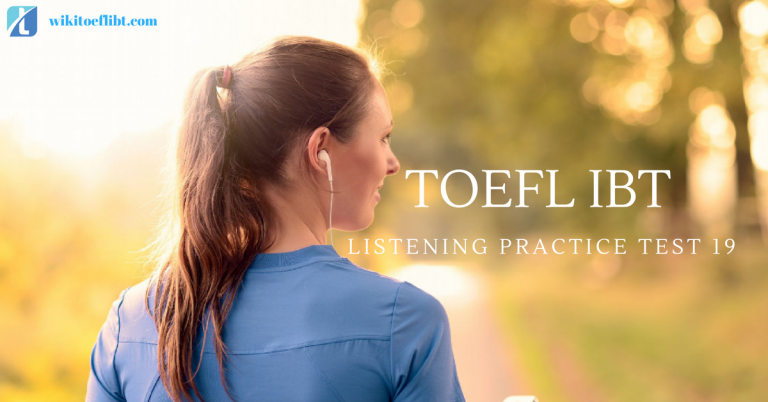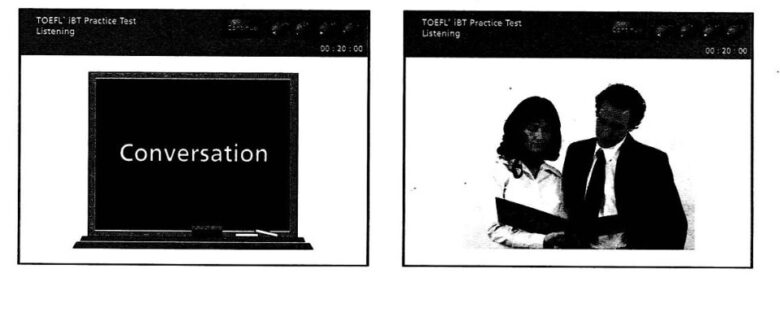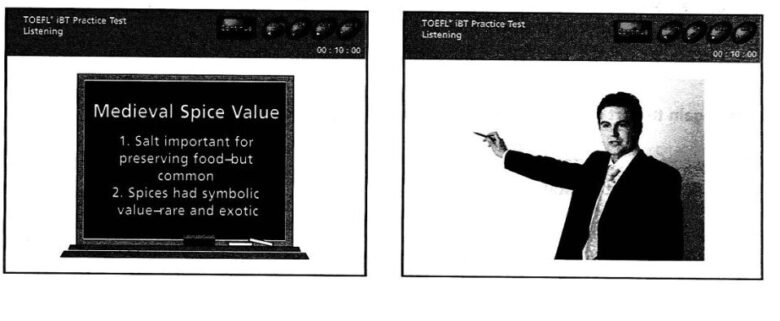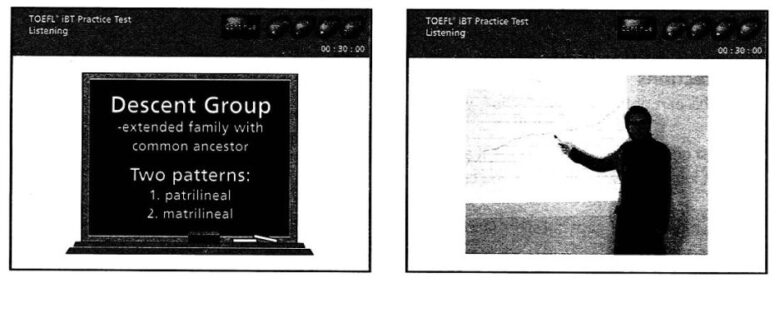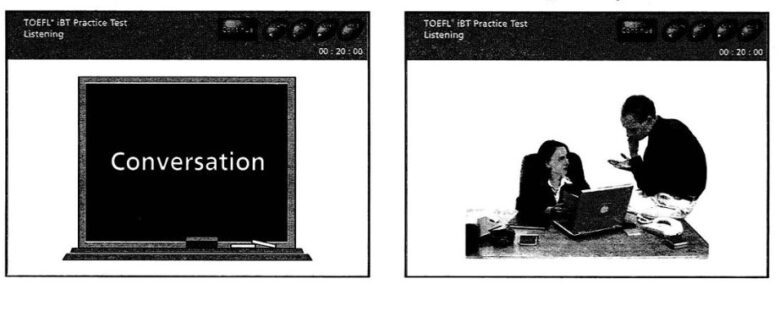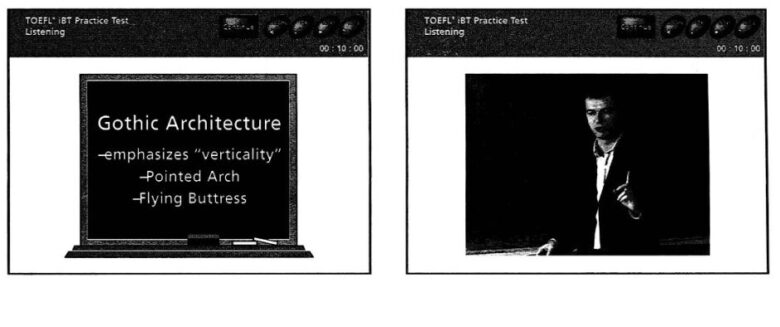TOEFL IBT Listening Practice Test 19 from Sharpening Skills for the TOEFL iBT four practice tests by Jeff Zetter & Micheal Pederson
Listening Section Directions
This test measures your ability to understand conversations and lectures in English.The Listening section is divided into 2 separately timed parts. In each part you will listen to 1 conversation and 2 lectures. You will hear each conversation or lecture only one time.
After each conversation or lecture, you will answer questions about it. The questions typically ask about the main idea and supporting details. Some questions ask about a speaker’s purpose or attitude. Answer the questions based on what is stated or implied by the speakers.
You may take notes while you listen. You may use your notes to help you answer the questions. Your notes will not be scored. If you need to change the volume while you listen, click on the Volume icon at the top of the screen.
In some questions, you will see this icon: This means you will hear, but not see, part of the question. Some of the questions have special directions. These directions appear in a gray box on the screen.
Most questions are worth 1 point. If a question is worth more than 1 point, it will have special directions that indicate how many points you can receive. You must answer each question. After you answer, click on Next. Then click on OK to confirm your answer and go on to the next question. After you click on OK, you cannot return to previous questions.
A clock at the top of the screen will show you how much time is remaining. The clock will not count down while you are listening. The clock will count down only while you are answering the questions.
TOEFL IBT Listening Practice Test 19 from Sharpening Skills for the TOEFL iBT four practice tests by Jeff Zetter & Micheal Pederson
Listening 1
Listen to part of a lecture in a psychology class. Trade 1
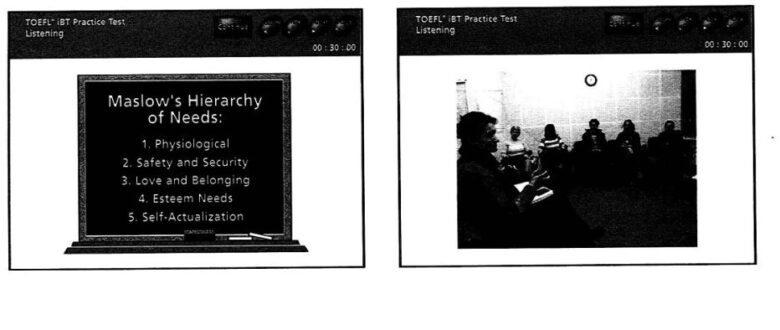
Now get ready to answer the questions. You may use your notes to help you answer.
1. What is the lecture mainly about? Track 2
(A) A comparison of different approaches to human development
(B) A process for meeting human needs
(C) A system of classifying human needs
(D) Experiments testing a theory of human development
2. According to the professor, what did Maslow realize from studying monkeys? Track 3
(A) They are very similar genetically to humans.
(B) They need very little other than food and water.
(C) They need the same things humans need.
(D) They placed meeting certain needs before meeting others..
3. According to the professor, which of the following is a feature of self-actualized individuals?
Track 4
(A) Having a limited sense of humor
(B) Being well-loved by all people
(C) Having a well-developed awareness of ethics
(D) Having completed growth
4. In the lecture, the professor describes the layers in Maslow’s hierarchy of human needs. Indicate whether each of the following is mentioned as one of those layers. Track 5
For each word or phrase, put an X in the YES or NO column.
YES NO
A. Physiological needs
B. Anxiety needs
C. Religious needs
D. Esteem needs
Listen again to part of the lecture. Then answer the question. Track 6
5. Why does the professor say this: ?
(A) To challenge students to explain what she meant
(B) To see if students need additional examples
(C) To introduce the next idea in the lecture
(D) To check the students’ understanding of the preceding levels
6. What would the professor most likely talk about next? Track 7
(A) Why certain people meet more of their needs than others
(B) What a person can do to attain self-actualization
(C) How educators have applied Maslow’s ideas in classrooms
(D) How Maslow’s ideas are challenged by experts
__________________________________________________
Listening 2
Listen to part of a conversation between a student and a professor. Trade 8
7. Why does the student go to see her professor? Track 9
(A) To ask the professor for information about the computer support department
(B) To discuss the final draft for her paper
(C) To inform the professor that she lost her paper when her computer crashed
(D) To get advice on her paper topic
8. What does the student say about the computer support department? Track io
(A) She already went there and they reformatted her hard drive.
(B) She doesn’t trust the people who work there.
(C) She is planning to go there to have them fix the hard drive.
(D) She already went there and found out her computer couldn’t be fixed.
9. What did James say about the woman’s computer? Track 11
(A) A virus destroyed all the information on her hard drive.
(B) It was infected by a spyware program.
(C) It needs a new power supply that had to be ordered from China.
(D) He couldn’t figure out the problem with it.
10. Why must the student hand in the paper tomorrow morning? Choose 2 answers. Track 12
(A) The semester is over tomorrow.
(B) The student is leaving for a conference.
(C) The professor must submit grades by tomorrow.
(D) Tomorrow is the end of her extension.
(E) The professor is leaving for a conference.
Listen again to part of the conversation. Then answer the question. Track 13
11. What can be inferred about the professor’s attitude?
(A) He wants the student to solve her own problem.
(B) He thinks he cannot help the student.
(C) He wants to express sympathy with the student.
(D) He wants the student to learn from his mistake.
Listen again to part of the conversation. Then answer the question. Track 14
12. Why does the professor say this: ?
(A) To suggest that she should make more improvements
(B) To recognize that her previous work was not of high quality
(C) To acknowledge that her previous work will help her grade
(D) To suggest that she can only get a good grade if her paper improves
_________________________________________________
Listening 3
Listen to part of a lecture in a history class. Trade 15
13. What is the lecture mainly about? Track 16
(A) The differences between salt and pepper
(B) The symbolic importance of spices in the Middle Ages
(C) The structure of the medieval European spice trade
(D) How pepper made it to our dinner table
14. According to the professor, why was salt so valuable to early peoples? Track 17
(A) It tasted better than pepper, cinnamon, or other spices.
(B) It had its origins in mysterious and distant lands.
(C) It is necessary to human health.
(D) It could keep foods from spoiling.
15. According to the professor, Europeans probably did NOT Track 18
(A) use salt and herbs to preserve food
(B) use salt and herbs to flavor food
(C) use pepper and spices to preserve food
(D) use pepper and spices to flavor food
16. Why does the professor mention that most Europeans in the Dark Ages only knew about the world within a ten-mile radius of their homes? Track 19
(A) To emphasize their mistrust of outsiders and dependence on the Church
(B) To illustrate how common spices today could seem exotic to them
(C) To show students how the spice trade changed European social organization
(D) To point out how spices were generally traded only short distances
17. What does the professor suggest about medieval European attitudes toward pepper and salt?
Track 20
(A) Pepper tasted better than salt.
(B) Pepper had less preservative value than salt.
(C) Salt had become part of European culture but pepper had not.
(D) Salt had less symbolic value than pepper.
Listen again to part of the lecture. Then answer the question. Track 21
18. Why does the professor say this: ?
(A) To imply that he would rather not talk about religion
(B) To show that the Church had a special status
(C) To announce a later topic of discussion
(D) To indicate why he does not say more about the Church
________________________________________________
Listening 4
Listen to part of a lecture in an anthropology class. Trade 22
1. What aspect of kinship does the professor mainly discuss? Track 23
(A) Matrifineal groups
(B) Descent groups
(C) Patrilineal groups
(D) Marriage patterns
2. The professor notes that the common ancestor of a descent group may be Track 24
(A) alive
(B) fictitious
(C) lineal
(D) economic
3. Which statement accurately conveys a relationship described in the lecture? Track 25
(A) Matrilineal descent is one kind of patrilineal descent.
(B) A family is one kind of descent group.
(C) A descent group is one type of social institution.
(D) A relative is one type of ancestor.
4. What does the professor say about Chinese tsu descent groups? Track 26
(A) They were organized along matrilineal lines.
(B) They included four or more generations in the household.
(C) They traced descent along the father’s line.
(D) They allowed uncles to discipline children.
5. In what ways does the matrilineal descent system shape Hopi households? Choose 2 answers. Track 27
(A) It allows a woman to live near her relatives.
(B) It permits children to choose if they will belong to their mother’s clan.
(C) It allows a man to divorce his wife in a simple manner.
(D) It allows a woman to share in owning land.
Listen again to part of the lecture. Then answer the question. Track 28
6. Why does the professor ask this: ?
(A) To find out about students’ family backgrounds
(B) To illustrate an issue interesting to anthropologists
(C) To remind students of the definition of “descent group”
(D) To point out the main cause of family disputes
____________________________________________________-
Listening 5
Now listen to part of a conversation between a student and a university housing official. Track 29
Now get ready to answer the questions. You may use your notes to help you
7. Why does the student go to the student housing office? Track 30
(A) To inform them of his new roommate
(B) To find out how much money he owes
(C) To correct a mistake in his bill
(D) To try to get a refund on his bill
8. In which building does the student currently live? Trade 31
(A) Smith Tower
(B) Burns Hall
(C) Frederickson Tower
(D) Terrence Hall
9. What does the woman say the student needs to do after he gets a confirmation letter? Trade 32
(A) Go to the Registrar’s office to choose his classes
(B) Talk to his Resident Assistant for a new ID card
(C) Go to Security to update his ID card
(D) Talk to the Associate Director about changing rooms
Listen again to part of the conversation. Then answer the question. Track 33
10. Why does the student say this: ?
(A) He is trying to persuade the woman to give him money.
(B) He is being playful and is joking.
(C) He is clarifying what he said earlier.
(D) He is thanking the woman for offering him money.
Listen again to part of the conversation. Then answer the question. Track 34
11. What does the student imply when he says this: ?
(A) That he hopes the process will not take a long time
(B) That he is interested in learning more about university procedures
(C) That he hopes the process will be slow so he does not have to register
(D) That the woman is not working very efficiently
12. What will the student most likely do next? Track 35
(A) Pay the money he still owes
(B) Write a letter to James Frederickson
(C) Stop by the Security Office
(D) Go to see his building’s Resident Assistant
13. What is the talk mainly about? Track 37
(A) Roman churches
(B) A development in architecture
(C) Different styles of arches
(D) The use of stained-glass windows
_____________________________________________
Listening 6
Now listen to part of a talk in an art history class. Track 36
14. By mentioning Romanesque architecture, the professor Track 38
(A) describes Europe’s oldest form of architecture
(B) gives his students something to compare Gothic architecture to
(C) explains how vaults, portals, and other design features work
(D) shows that Gothic architecture was simpler and more functional
15. According to the talk, impressive cathedral windows were made possible by the use of
Track 39
(A) barrel vaults
(B) stout columns
(C) pointed arches
(D) steel skeletons
16. The lecturer notes that the Cathedral of Ulm is remarkably Track 40
(A) tall
(B) Gothic
(C) German
(D) open
17. Why does the professor say this: ?
(A) To correct a mistaken assumption about Gothic Revival architecture
(B) To clarify that his remarks pertain to original Gothic structures
(C) To emphasize the continued popularity of Gothic architecture
(D) To express his approval of Gothic Revival structures
18. According to the talk which of the following architectural features matches each style? Track 42
Put an X in the correct column for each word or phrase.
Feature: Gothic architecture Romanesque architecture
(A) Barrel vaults
(B) Spires
(C) Broad columns
(D) Round arch
(E) Gargoyles
(F) Tall windows

